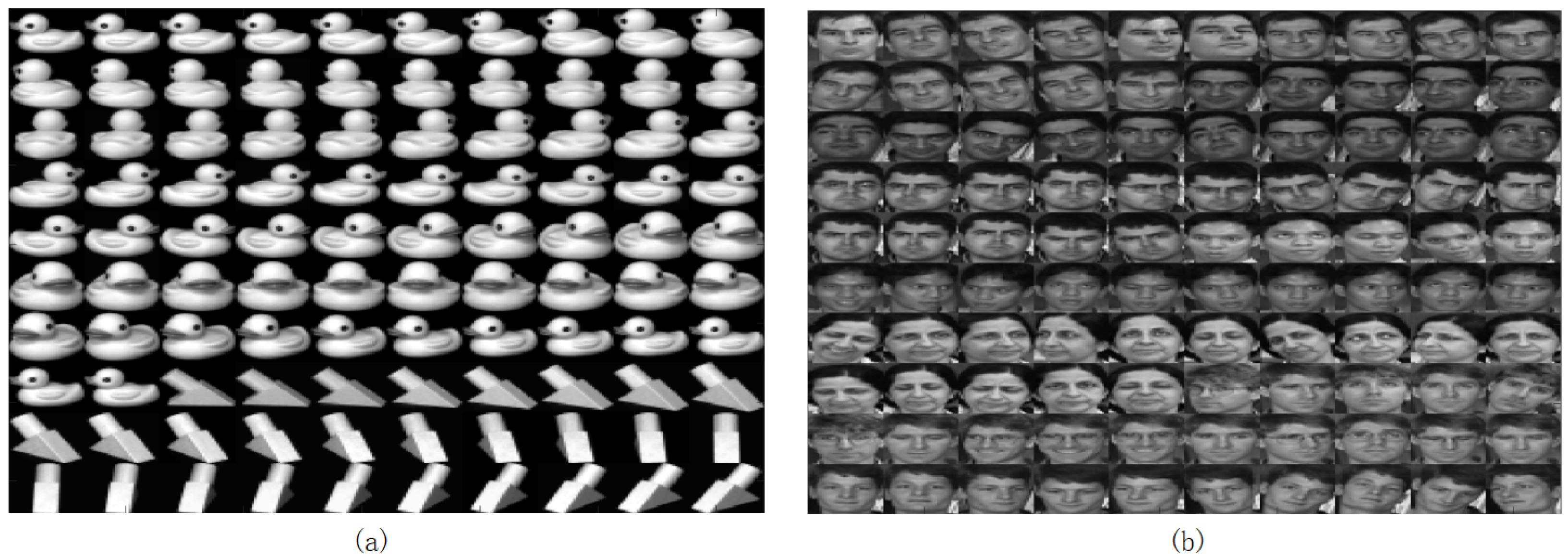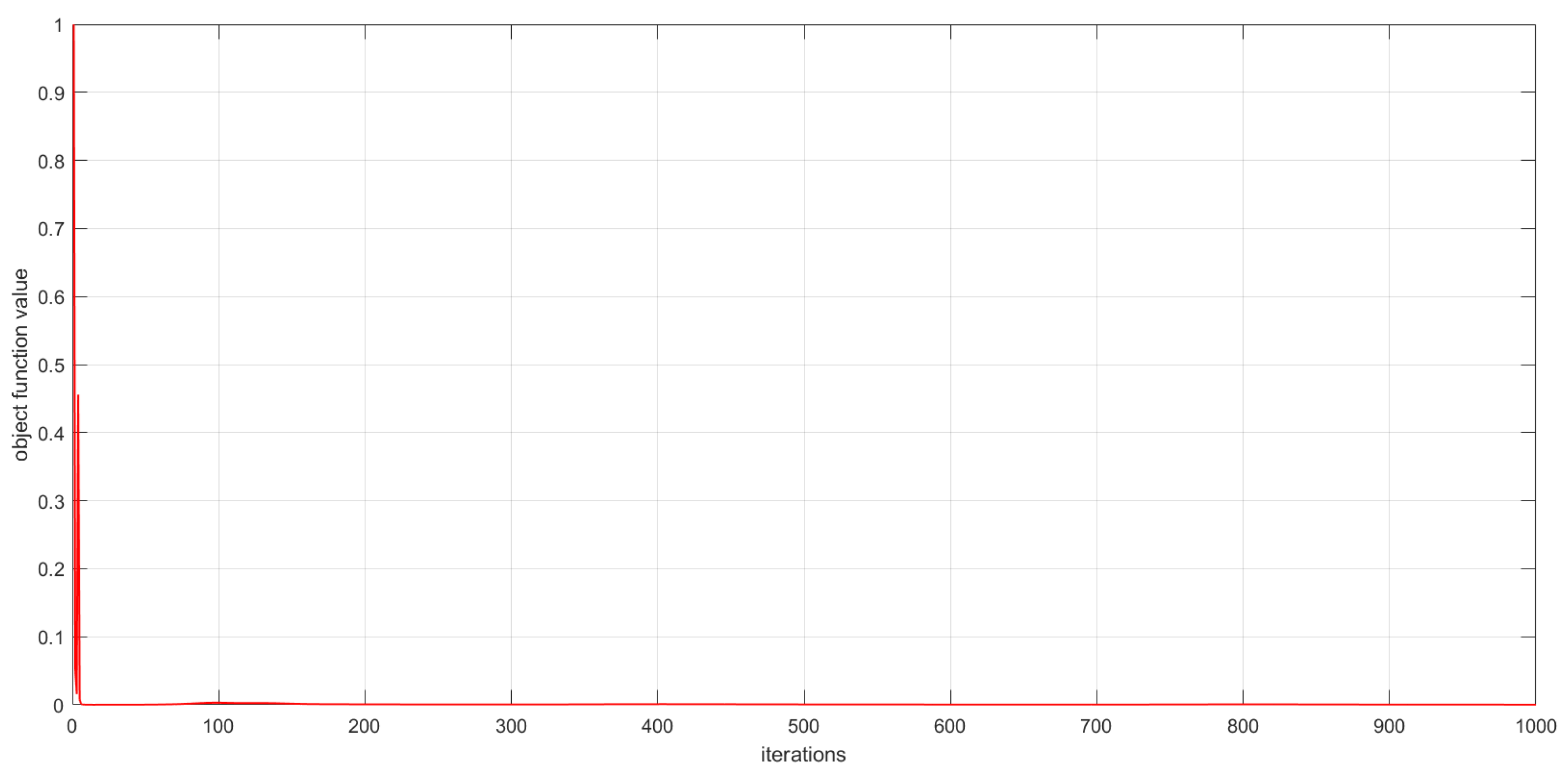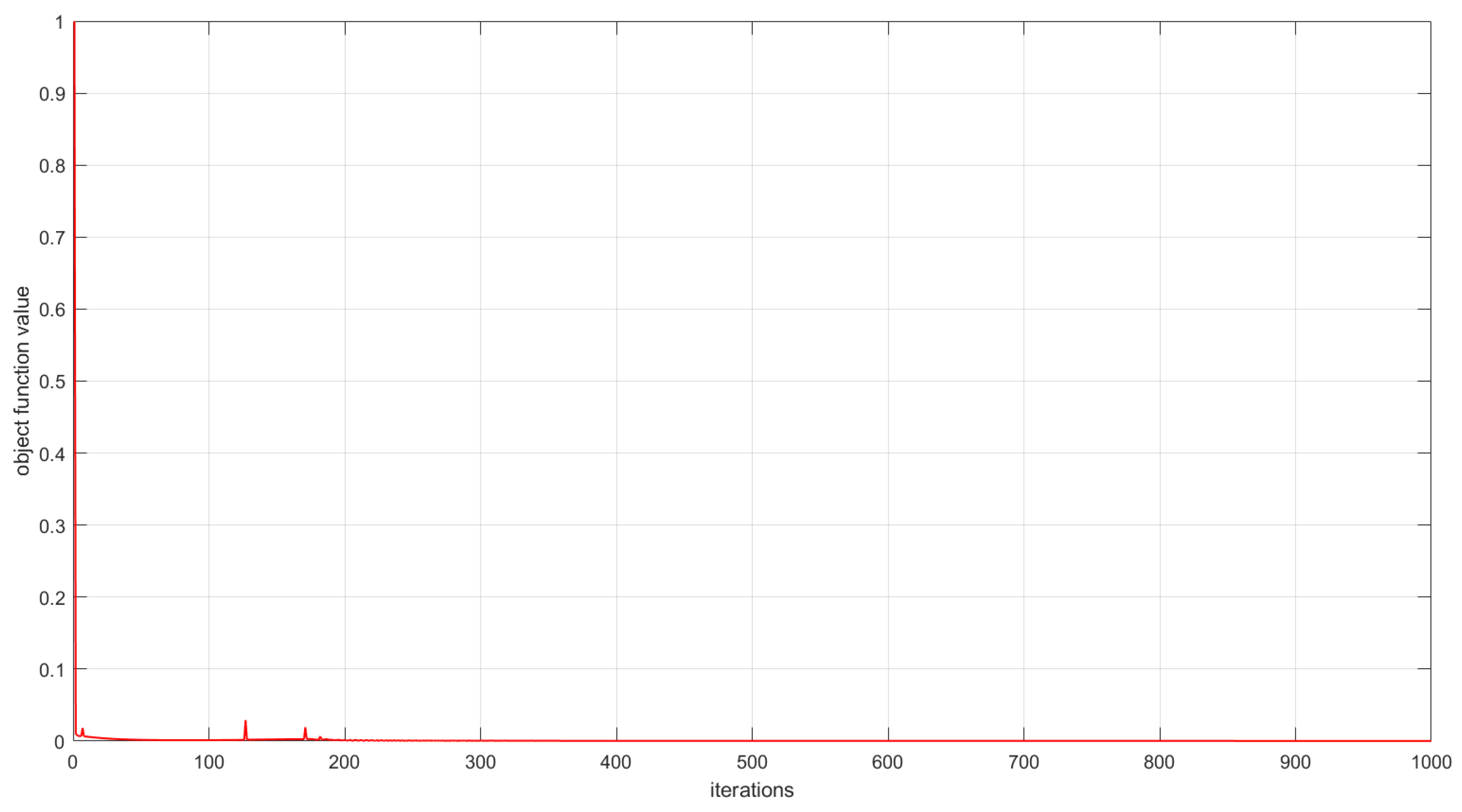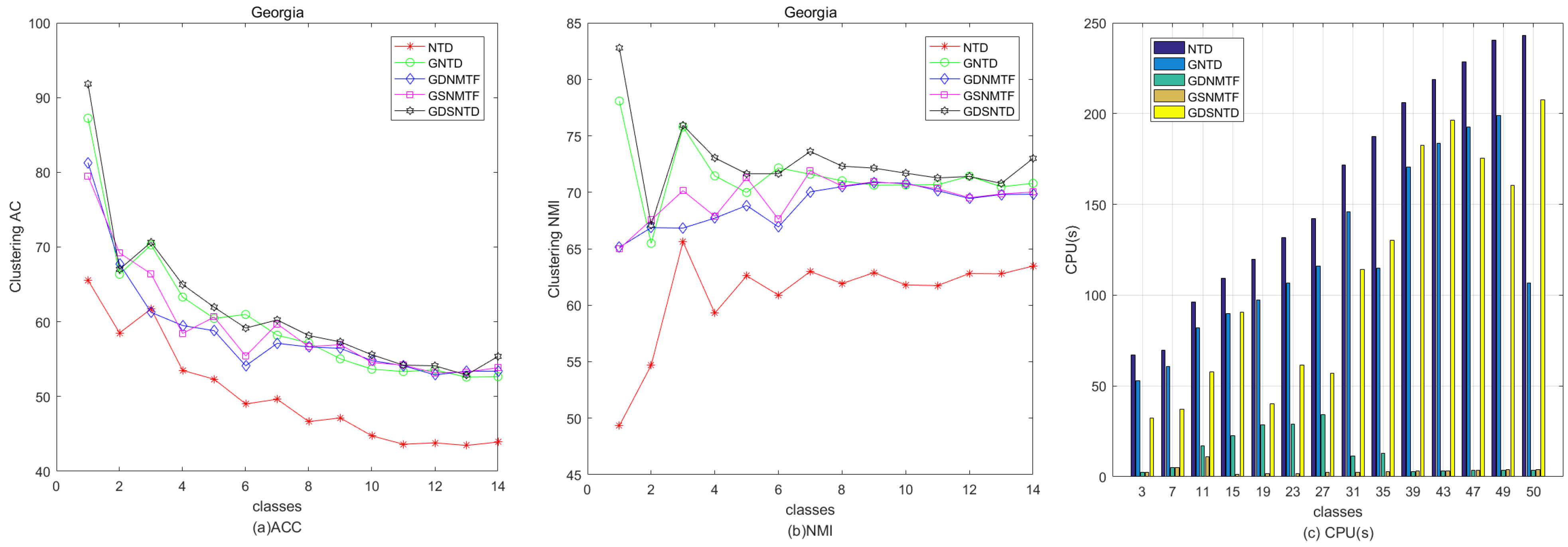1. Introduction
Non-negative decomposition is a general term for a type of matrix or tensor decomposition method that requires all components in the decomposition result to be non-negative. The core idea is to decompose a non-negative data matrix or tensor into the product of several non-negative factor matrices or core tensors in order to extract interpretable latent features or components from non-negative data. The most representative non-negative decompositions are non-negative matrix factorization (NMF) and its extension in the high-dimensional domain non-negative Tucker decomposition (NTD). NMF is a common dimensionality reduction method that can extract the main features from the original data and has high interpretability [
1]. When data requires more than two indices to be uniquely identified, it should be expressed in the form of a tensor. Thus, a tensor is naturally viewed as a generalization of vectors (first-order tensors) and matrices (second-order tensors) to higher orders. Non-negative tensor decomposition is a multi-dimensional data analysis method based on matrix decomposition, which can transform high-dimensional data into low-dimensional representations and retain the main features of the original data [
2]. Shcherbakova et al. investigated the advantages of non-negative Tucker decomposition [
3]. Like matrix decomposition, the purpose of tensor decomposition is to extract the information or main components hidden in the original data [
4,
5]. The Tucker decomposition is a tensor factorization method designed for handling tensor data [
6]. NTD is a concrete application of Tucker decomposition in non-negative matrix decomposition. Its core idea is to decompose a high-order non-negative tensor into the product of a core tensor and a series of factor matrices [
7]. NTD not only retains the interpretability benefits of NMF but also effectively preserves the inherent multi-way structure of the original tensor data. Consequently, non-negative Tucker decomposition (NTD) is extensively utilized in a wide range of disciplines, including image analysis and text mining, to uncover the latent structures inherent in multi-way datasets.
To improve model performance, numerous regularized extensions of NMF and NTD have been developed in the recent literature. These models have demonstrated excellent performance in image clustering or data mining. Cai et al. introduced the graph-regularized non-negative matrix factorization (GNMF) algorithm, which incorporates a geometrically-based affinity graph into the NMF framework to preserve the local manifold structure of the data [
8]. Sun et al. proposed graph-regularized and sparse non-negative matrix factorization with hard constraints (GSNMFC), jointly incorporating a graph regularizer and hard prior label information as well as a sparseness constraint as additional conditions to uncover the intrinsic geometrical and discriminative structures of the data space [
9]. They also proposed sparse dual graph-regularized non-negative matrix factorization (SDGNMF), jointly incorporating the dual graph-regularized and sparseness constraints as additional conditions to uncover the intrinsic geometrical, discriminative structures of the data space [
10]. Shang et al. proposed a novel algorithm, called graph dual regularization non-negative matrix factorization (DNMF), which simultaneously considers the geometric structures of both the data manifold and the feature manifold [
11]. Long et al. proposed a novel constrained non-negative matrix factorization algorithm, called the graph-regularized discriminative non-negative matrix factorization (GDNMF), to incorporate into the NMF model both the intrinsic geometrical structure and discriminative information [
12]. Saberi-Movahed et al. present a systematic analysis of NMF in dimensionality reduction, with a focus on both feature extraction and feature selection approaches [
13]. Jing et al. proposed a novel semi-supervised NMF method that incorporates label regularization, basis regularization, and graph regularization [
14]. Li et al. developed a manifold regularization non-negative Tucker decomposition (MR-NTD) model. To preserve the geometric information within tensor data, their method employs a manifold regularization term on the core tensor derived from the Tucker decomposition [
15]. Yin and Ma incorporated this geometrically based Locally Linear Embedding (LLE) into the original NTD, thus proposing NTD-LLE for the clustering of image databases [
16]. To enhance the representation learning of tensor data, Qiu et al. proposed a novel graph-regularized non-negative Tucker decomposition (GNTD) framework [
17]. This method is designed to jointly extract low-dimensional parts-based representations and preserve the underlying manifold structure within the high-dimensional tensor data.
The above research demonstrates that the non-negative decomposition model significantly improves image clustering performance. However, advancements in scientific technologies have led to increasingly complex phenomena, rendering previous models inadequate for handling the resulting complexities. Building on this foundation, a common strategy to enhance image clustering accuracy has been the development of collaborative clustering (co-clustering) frameworks. This is typically achieved by incorporating specific regularization terms that capture the relationships between different data views or clusters. Co-clustering is an ensemble learning method that performs simultaneous clustering along multiple dimensions or data views [
18]. When using the non-negative matrix model, the goal of co-clustering is to simultaneously identify the clusters of both the rows and columns of the two-dimensional data matrix [
19]. Del Buono and Pio present a process which aims at enhancing the performance of three-factor NMF as a co-clustering method, by identifying a clearer correlation structure represented by the block matrix [
20]. Deng et al. proposed graph-regularized sparse NMF (GSNMF) and graph-regularized sparse non-negative matrix tri-factorization (GSNMTF) models. By incorporating an
norm constraint on the low-dimensional matrix, they aimed to scale the data eigenvalues and enforce sparsity. This co-clustering approach has been shown to enhance the performance of standard non-negative matrix factorization models [
21]. Chachlakis, Dhanaraj, Prater-Bennette, and Markopoulos presented Dynamic
-Tucker: an algorithm for dynamic and outlier-resistant Tucker analysis of tensor data [
22]. The
norm is extensively used in convex optimization problems [
23]. Ahmed et al. study a tensor-structured linear regression model over the space of sparse, low Tucker-rank tensors [
24]. As deep learning models become larger and more complex, sparsity is emerging as a critical consideration for enhancing efficiency and scalability, making it a central theme in the development of new image processing and data analysis methods.
As illustrated by the above studies, building upon NMF, scholars have developed numerous models to address the evolving needs of various scientific fields. The performance of the NMF model can be significantly improved through the combined constraints of graph regularization and sparsity, which directly exploit the internal structure and inherent characteristics of the data. NTD is the extension of NMF to the high-dimensional domain. However, there are relatively few co-clustering methods for constructing high-performance NTD models that leverage the internal structure and inherent characteristics of the tensor data itself. While GNTD captures graph structure and sparse NMTF promotes sparsity, neither is designed to simultaneously learn from multiple graphs while enforcing directional sparsity patterns across different data modes. To address this gap, and inspired by advancements in co-clustering NMF, this paper proposes a GDSNTD model based on GNTD for enhanced co-clustering. The new model combines graph regularization, the Frobenius norm, and the norm to simultaneously optimize the objective function. In NTD, graph regularization serves to preserve the multi-linear structure of the original data. The review of the prior literature revealed that imposing multiple graph constraints on NMF models enhances their clustering performance. Motivated by this finding, we consequently introduce dual graph constraints into the NTD framework, applying them directly to the factor matrices of a tensor. This approach allows the model to capture the intrinsic data geometry more clearly, thereby improving clustering accuracy. Furthermore, we provide updated iterative optimization rules and prove the convergence of the model. Experiments on public datasets demonstrate that the proposed method outperforms several leading state-of-the-art methods.
The main contributions of this study are as follows:
We introduce dual graph constraints into the NTD framework, applying them directly to the factor matrices of a tensor. To the best of our knowledge, no existing NTD framework integrates dual graph constraints with sparse regularization simultaneously. While graph-regularized and sparse factorization techniques exist, our model GDSNTD is the first to integrate them in a unified, constrained co-clustering optimization framework for NTD. We propose a new co-clustering version of the NTD model, equipped with three regularization terms: graph regularization, the Frobenius norm, and the norm. The graph regularization term captures the internal geometric structure of high-dimensional data more accurately. The norm term helps to scale original features in the factor matrices. The Frobenius norm improves the generalization ability of the model. Therefore, the co-clustering GDSNTD integrates strengths from graph-regularized and sparse factorization techniques so that the model yields a more accurate solution to the optimization problem.
In the novel, unified optimization objective, we leverage the L-Lipschitz condition to derive the update rules for the proposed co-clustering GDSNTD method. Subsequently, we establish the convergence of the proposed algorithm.
Experiments on public datasets demonstrate the effectiveness and superiority of the proposed method.
The remainder of the paper is organized as follows. In
Section 2, we review the related models. In
Section 3, the GDSNTD method is proposed, and its detailed inference process and the proof of convergence of the algorithm are illustrated.
Section 4 presents the performance of the proposed model via experiments on various datasets. Finally, we present our conclusions in
Section 5 and outline future work in
Section 6.
4. Experiments
The details of the public datasets used in the experiments are presented in
Figure 1 and
Figure 2.
In order to evaluate the effectiveness of our proposed GDSNTD scheme, we compared it with six classical or state-of-the-art clustering and co-clustering methods. All the simulations were performed on a computer with a 2.30-GHz Intel Core i7-11800H CPU and 32 GB memory of 64-bit MATLAB 2016a in Windows 10. Without special specifications, the maximum number of iterations is set to 1000.
Non-negative matrix factorization (NMF) [
1]: NMF aims to decompose a matrix into two low-dimensional matrices and is now often used as a data processing method in machine learning.
Non-negative Tucker decomposition (NTD) [
7]: The NTD algorithm is considered as a generalization of NMF.
Graph-regularized NTD (GNTD) [
17]:
Graph dual regularized NMF (GDNMF) [
12]: GDNMF simultaneously considers the geometric structures of both the data manifold and the feature manifold.
Graph dual regularized non-negative matrix tri-factorization (GDNMTF) [
12]: DNMTF is an extension of our DNMF algorithm and simultaneously incorporates two graph regularizers of both data manifold and feature manifold into its objective function.
Graph-regularized sparse non-negative matrix trifactorization (GSNMTF) [
21]: The GSNMTF model introduces graph regularization and an
norm constraint into the objective function.
4.1. Evaluation Measures
In this section, two widely used metrics, accuracy (AC) and Normalized Mutual Information (NMI), are used to evaluate the clustering performance. Accuracy aims to find a one-to-one relationship between classes and clusters. It is usually used to calculate the proportion of correct samples to the total number of samples. It is a relatively intuitive evaluation index. Accuracy is a clustering evaluation metric that measures the proportion of correctly assigned samples against the total, after a one-to-one mapping between clusters and true classes is established. It is an intuitive and widely used measure [
31]. NMI is commonly used in clustering to measure the similarity between two clusterings.
AC is defined as
where
N is the total number of samples,
is the ground-truth label of sample
i,
is the cluster label assigned by the algorithm,
is the Dirac delta function, and
is the optimal mapping function [
32].
NMI is defined as
where
is the mutual information between
B and
T, and
and
are their entropies. A higher NMI indicates a better alignment between the clustering result and the true labels [
33].
4.2. Experimental Setup and Clustering Results Analysis
In this part, the experimental setup is described, and the experimental results are discussed in detail. To ensure the fairness between models, our proposed algorithm and all comparison algorithms use the same random initialization matrix. Subsequently, each experiment is conducted ten times independently on original data, then K-means clustering is performed five times independently on this low-dimensional reduced data. The average and variance of the results are recorded. The standard deviation is set to 0 if it is less than .
Table 2 and
Table 3 summarize the accuracy and NMI results for each algorithm across all datasets.
Table 4 lists the accuracy and standard deviation for each algorithm on the Georgia dataset, while
Table 5 presents the corresponding NMI results. Similarly, results for the COIL20 dataset are detailed in
Table 6 (accuracy) and
Table 7 (NMI). From the results, we derive the following main conclusions:
- 1.
From
Table 2, we can observe that the value of AC of GDSNTD is better than that of other methods on most datasets. The value of NMI reflects the proportion of correct decisions, which also proves that the proposed model performs better. The performance improvement is evident in the
Georgia dataset, where GDSNTD improves the accuracy by 48.92% over the NMF co-clustering algorithm. The accuracy of GDSNTD is also improved by 26.1%, 5.15%, 7.02%, 3.71%, and 2.82% compared with other co-clustering algorithms NTD, GNTD, GDNMF, GDNMTF, and GSNMTF, respectively. In the
Coil20 dataset, the accuracy of GDSNTD is also improved by 30.50%, 38.58%, 2.29%, 0.81%, 1.14%, and 0.57%, compared with other co-clustering algorithms NTD, GNTD, GDNMF, GDNMTF, and GSNMTF, respectively. In the
Iris dataset, the accuracy of GDSNTD is improved by 17.22%, 32.77%, 2.84%, 2.10%, 0.17%, and 0.12% compared with other co-clustering algorithms NMF, NTD, GNTD, GDNMF, GDNMTF, and GSNMTF, respectively.
- 2.
From
Table 3, we can observe that our proposed method of GDSNTD can also achieve higher accuracy. The NMI of GDSNTD is as high as 50.16% on the
Iris dataset, which is 34.95%, 7.46%, 4.27%, 3.49%, and 3.42% better compared with NMF, GNTD, GDNMF, GDNMTF, and GSNMTF, respectively. In the
Georgia dataset, the accuracy of GDSNTD is also improved by 26.67%, 15.01%, 3.12%, 4.79%, 4.54%, and 4.26% compared with other co-clustering algorithms NMF, NTD, GNTD, GDNMF, GDNMTF, and GSNMTF, respectively. In the
Coil20 dataset, the accuracy of GDSNTD is improved by 21.02%, 23.85%, 2.75%, 0.3%, 0.2%, and 0.32%, compared with other co-clustering algorithms NMF, NTD, GNTD, GDNMF, GDNMTF, and GSNMTF, respectively.
- 3.
Table 4 shows that the average AC of GDSNTD is higher than that of the other methods on most datasets. In the
Georgia dataset, the accuracy of the co-clustering algorithm GDSNTD is improved by an average of 27.4%, 22.6%, 2.2%, 8.7%, 5.11%, and 3.79% compared with NMF, NTD, GNTD, GDNMF, GDNMTF, and GSNMTF, respectively. From
Table 6, it can be observed that on the
Coil20 dataset, the accuracy of GDSNTD is, on average, 23.9%, 30.9%, 1.49%, 4.0%, 5.79%, and 3.18% higher than that of NMF, NTD, GNTD, GDNMF, GDNMTF, and GSNMTF, respectively.
- 4.
From
Table 5, it can be observed that on the
Georgia dataset, the accuracy of GDSNTD is, on average, 23.7%, 19.4%, 1.82%, 7.3%, 5.67%, and 4.63% higher than that of NMF, NTD, GNTD, GDNMF, GDNMTF, and GSNMTF, respectively. From
Table 7, it can be observed that on the
Coil20 dataset, the accuracy of GDSNTD is, on average, 20.8%, 31.5%, 1.42%, 3.2%, 6.14%, and 2.76% higher than that of NMF, NTD, GNTD, GDNMF, GDNMTF, and GSNMTF, respectively.
Figure 3 shows the clustering performance on the Georgia, COIL20, and Iris datasets. It can be observed that the proposed GDSNTD method surpasses all other compared methods.
4.3. Interpretation of GDSNTD’s Superior Performance
Across all datasets, our proposed method consistently outperforms all competing baselines of NMF, NTD, GNTD, GDNMF, GDNMTF, and GSNMTF in both standard clustering and co-clustering tasks. This empirical evidence strongly suggests that the GDSNTD model with dual graph constraints successfully leads to a more structured and discriminative latent space, thereby improving clustering accuracy.
First, applying manifold constraints to the factor matrices is equivalent to preserving the structure in the “essential features” of the data, resulting in greater accuracy. Second, regularization counterbalances the Frobenius norm, leading to a more stable optimization process and yielding factors within a more reasonable numerical range. Furthermore, regularization promotes the learning of “parts” that correspond to local structures within the data, thereby promoting a decomposition with enhanced coherence.
4.4. Parameter Selection
Every parameter is searched over a range of values from 0 to
. The choice of parameters has a pronounced effect on experimental performance; therefore, they were selected systematically through a grid search.
Figure 4 shows the process of determining the optimal parameters using a grid search on the
Iris dataset. From
Figure 4, we can see that the accuracy is only
when
and
. When the coefficient of the sparse regularization term is
, the accuracy improves to
. From
Figure 5, it is to be observed that the NMI is
when
and
, and when the coefficient of the sparse regularization term is
, the accuracy is only
.
4.5. Convergence Study
As described in
Section 3, the convergence of the proposed algorithms has been theoretically proved. In this subsection, we experimentally analyze the convergence of the proposed algorithms by examining the relationship between the number of iterations and the value of the objective function. This relationship is visualized in
Figure 6,
Figure 7 and
Figure 8. The convergence behavior of GSNTD on the
Georgia dataset is illustrated in
Figure 6. The convergence behavior of GSNTD on the
Coil20 dataset is illustrated in
Figure 7. The convergence behavior of GSNTD on the
Iris dataset is illustrated in
Figure 8. The observed monotonic decrease in the objective function value demonstrates that the algorithm converges effectively under the multiplicative update rules. This result provides empirical support for the convergence proof given in Theorem 1. We can find that GDSNTD is usually able to reach convergence within 1000 iterations.
4.6. Complexity Analysis
In this subsection, we analyze the computational complexity of GDSNTD. Note that is a third-order -dimensional tensor, and is a third-order -dimensional core tensor. Factor matrices are , , and .
Consider the updating rule in (8), the operation corresponds to the tensor mode product . Its computational complexity is . corresponds to . The computational complexity is . The total computational complexity of computing the update of is bounded by .
Consider the updating rule in (13), corresponds to , which needs operations. corresponds to , which needs operations. The total computational complexity of computing the update of is bounded by .
Consider the updating rule in (23), corresponds to , and it takes operations. corresponds to , and it takes operations. The total computational complexity of computing the update of is bounded by .
Similarly, consider the updating rule in (34), the total computational complexity of computing the update of is bounded by .
Therefore, the total computational complexity of the proposed method is . Compared with GNTD, the total computational complexity of the GDSNTD is increased by .
Figure 9 shows the relative performance in terms of clustering ACC and time consumption among NTD, GNTD, GDNMTF, GSNMTF, and GDSNTD on the
Georgia dataset.
Figure 10 shows the relative performance in terms of clustering NMI and time consumption among NTD, GNTD, GDNMTF, GSNMTF, and GDSNTD on the
Coil20 dataset. In the figure, CPU(s) is the running time in seconds.
6. Future Work
Although the proposed GSNTTD method has shown good clustering performance, it operates on the assumption that the data resides in a well-formed latent vector space [
34]. In recent years, deep learning-based clustering has experienced rapid advancement. The current popular deep learning-based methods are dominated by several key approaches, such as Graph Autoencoders (GAEs), graph convolutional network-based clustering (GCN-based clustering), and Deep Tensor Factorization.
GAEs aim to learn low-dimensional latent representations (embeddings) of graph-structured data in an unsupervised manner. It learns to compress input data into a lower-dimensional latent representation (encoding) and then reconstruct the original input from this representation (decoding). The critical distinction is that the input data is a graph, characterized by its topology (structure) and node attributes (features). Kipf et al. in [
35] formally introduced the GAE and its variational counterpart, the variational graph autoencoder (VGAE). The field of GAE has evolved rapidly from foundational models to highly sophisticated and specialized architectures. Recent advancements have focused on developing more sophisticated architectures to address specific challenges. Zhou K et al. proposed a new causal representation method based on a graph autoencoder embedded autoencoder (GeAE). The GeAE employs a causal structure learning module to account for non-linear causal relationships present in the data [
36].
Kipf and Welling in [
35] introduced the variational graph autoencoder (VGAE), a framework for unsupervised learning on graph-structured data based on the variational autoencoder (VAE). In this work, they demonstrated this VGAE model using a GCN encoder and a simple inner product decoder. In [
37], Kipf and Welling first introduced the efficient, first-order approximation-based graph convolutional layer. This formulation has laid the groundwork for numerous subsequent GCN studies. The core idea of a GCN encoder is to learn low-dimensional vector representations (i.e., node embeddings) for nodes by propagating and transforming information across the graph structure. The node’s embedding is determined not only by its own features but also jointly by the features of its neighbor nodes and the local graph structure. The core principle of GCN-based clustering is to unify node representation learning and cluster assignment into an end-to-end, jointly optimized framework and perform these tasks simultaneously.
The principle of Deep Tensor Factorization can be understood as using a deep neural network to perform the factorization and reconstruction process. Wu et al. proposed a Neural Tensor Factorization model, which incorporates a multi-layer perceptron structure to learn the non-linearities between different latent factors [
38]. In [
39], Jiang et al. proposed a generic architecture of deep transfer tensor factorization (DTTF), where the side information is embedded to provide effective compensation for the tensor sparsity.
In [
40], Ballard et al. categorized feedforward neural networks, graph convolutional neural networks, and autoencoders into non-generative deep learning-based multi-omics integration methods. They found that deep learning-based approaches build off of previous statistical methods to integrate multi-omics data by enabling the modeling of complex and non-linear interactions between data types. Therefore, deep learning-based clustering has emerged as a rapidly advancing field. It integrates conventional cluster analysis with deep learning, leveraging its powerful feature representation and non-linear mapping capabilities to demonstrate superior performance in unsupervised clustering tasks. In the future, we intend to incorporate recent deep learning-based methods into our subsequent research to explore more up-to-date clustering methodologies.















